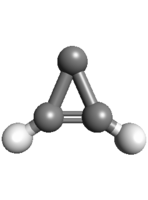|
Please note that this entry deals with the
symmetric isotopomer with one 13C.
The transition frequencies were largely taken
from
(1) M. Bogey, C. Demuynck, J. L. Destombes, and
H. Dubus,
1987, J. Mol. Spectrosc. 122, 313.
Additional lines were published by
(2) S. Spezzano, F. Tamassia, S. Thorwirth,
P. Thaddeus, C. A. Gottlieb, and M. C. McCarthy,
2012, Astrophys. J. Suppl. Ser. 200, Art. No. 1.
The uncertainties in (1) are overall somewhat
conservative. Nevertheless, one line with large
residuals in recent fits has been omitted from the
final fit. Some higher order parameters were taken from
the main spcies and were kept fixed after scaling.
Predictions with uncertainties larger than
0.5 MHz should be viewed with caution.
The 13C hyperfine splitting has been resolved
to a large degree in (2). The hyperfine splitting may be
be resolvable in astronomical observations of cold sources.
Therefore, a separate
hyperfine calculation is provided up to
J = 2 and up to 150 GHz.
The partition function values include the
spin-multiplicity of the 13C nucleus.
At lower temperatures, it may be useful to distinguish
between ortho-c-C3H2 and
para-c-C3H2.
The ortho and para levels are described by
Ka + Kc = odd
and even, respectively, with a spin-weight ratio of 3 : 1. The
JKaKc = 101
level is the lowest ortho state. However, it is
only 1.619243 cm–1 above ground.
Separate
para and
ortho predictions are available up to about
200 GHz along with separate
para and
ortho partition function values.
Note: the spin-weight
of 3 for the separate ortho predictions has not
been eliminated. Please note also that there are
matrix-elements which mix ortho and para levels.
However, these matrix-elements are small. Nevertheless,
larger effects may occur in cases of accidental
near-degeneracies of certain levels.
The dipole moment was assumed to agree with that of
the main species, see e038506.cat.
|
